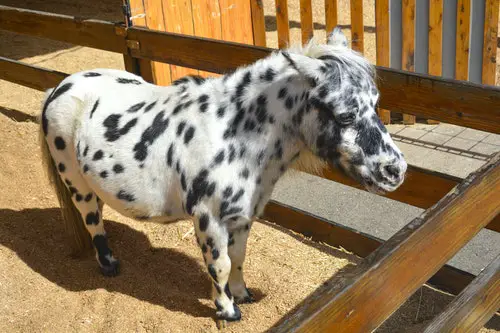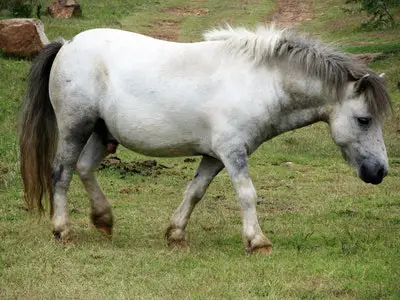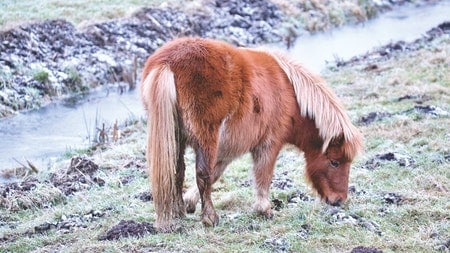A miniature horse – like its name suggests – is actually more modest than a regular horse. Most of them are made to breed because of their small size and people regularly confuse one with the other.
Admittedly, both of them are little equines, but that is honestly where the similarities end. However, something we can all agree on is that they are both fun to have around because of their cool and charming disposition. In this article, we’ll look at just what sets a pony and a miniature horse apart.
How Does A Pony Differ From A Miniature Horse?
The miniature horse is regarded as a rare breed, one that is a tad scaled down version of a bigger stallion while measuring approximately 34 inches around the shrivels. This breed is a relatively new one that has started to gain popularity among adults and young people due to its size.
Ponies are differentiated from normal-sized horses using their stature and size. Ponies are obviously considerably smaller (around 14.2 hands) as well as stockier than horses. They also come with thicker tails, manes and coats. Their body proportion – thicker neck, wider barrels and shorter legs – is quite peculiar and is also different to that of a normal-sized horse. A handful of breeds have been characterised as ponies and this ranges from the Hackney and Shetland breeds to the Exmoor and Fell breeds.

On the other hand, miniature horses are bred to look like normal-sized horses, but on smaller scales. One of the requirements, according to the association of miniature horses, is that they must be less than 34 inches which will also include the last hairs on their mane. Miniature horses are also measured in inches instead of hands. They have been bred to look more refined than ponies with a short back, long, flexible necks and straight legs.
Historical Influence
Throughout history, the roles miniature horses and ponies have played have contributed in what their current appearance, size and temperament have come to be.
The first appearance of mini horses was recorded to have happened in the year 1650 at the Versailles palace where the King (Louis XIV) had a zoo filled with unusual animals that included little horses. These mini horses were actually introduced in America to be used in coal mines because their size ensured that they were able to access the underground tunnels. Over time, they’ve been bred in other places like South America so as to improve their proportional and petite standard.
Ponies are hardier and stockier than a lot of horses. This can be attributed to them having to survive in unfavourable conditions. They appeared as domesticated animals in America during the 1800s and they were used in mines and in agricultural settings.
Why are some breeds not considered as ponies?
Some horse breeds, irrespective of their height, are regarded as horses. The miniature horse is clearly not a pony, although it can be distinguished by its height that doesn’t exceed 34 inches.

For example, the Caspian horse is an old mini horse breed that was initially thought to have gone into extinction. This changed in 1965 when a handful of them were discovered wandering close to the Caspian Sea’s shore. With its little frame and Arab-like head as well as light bone structure, this miniature horse is regarded as a horse because of its temperament, gait and characteristic conformation – even though it stands at barely 10 – 12 hands.
Other pony-sized breeds that are regarded as horses include the Fjord and the Icelandic. Even with their stocky build that resembles that of a pony, they are still regarded as horses.
A lot of the Breed Registries have said that due to the fact that miniature horses come with horse phenotype, it classifies them as horses rather than ponies. A phenotype is a group of observable traits of an individual that results from interaction of the genotype with its environment.
How did the miniature horse come into existence?
The miniature horse has been selectively bred for centuries from a wide range of horses and ponies. These pony breeds have evolved over a long period of time due to surviving hunger and unfavourable climate conditions.
This assertion is backed with the help of a very popular miniature horse of the 19th century. This horse was developed by the Falabellas in Argentina. They found herds of small horses living with the pampas. They subsequently garnered a herd meant to produce small horses that were bred to similar standards, temperament and conformation – just like normal-sized Thoroughbreds and Arabs.
On the other hand, the Shetland Pony came from the Shetland Islands. It subsequently evolved into the small, muscular and compact pony that we see now because of the extreme conditions it was subjected to.

Admittedly, there is an obvious difference in the development of both the Shetland and the Falabella breeds, but the reality is far more complicated. In the 17th and 18th century, European breeders had already started to selectively breed for small animals to serve as pets to noble families. By the 19th century, ponies were selectively bred to be small so that they could fit into tunnels that were in mines.
Some of these results can still be seen to this day among Shetland breeds. They still recognize standard Shetlands that measure close to 10.2 hands in height – as well as miniature Shetlands that stand at 34 inches maximum.
Classifying Horses with Dwarfism
A big difference between a miniature horse and a miniature Shetland is that a miniature horse isn’t as a result of the miniaturization of a certain breed or dwarf horse. However, dwarfism sometimes occurs during the process.
Dwarf horses are recognized by their large head and short limbs. They may appear quite normal at the early stages of birth, but the dwarf characteristics will be more pronounced as they grow older.
Dwarfism, in fact, can occur in all horse breeds, but it is quite prevalent in Shetlands, Friesians and miniature horses. This occurs when the mare and stallion both have the recessive gene. That’s why actual miniature horses can still produce dwarf foals.

